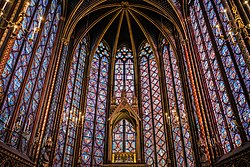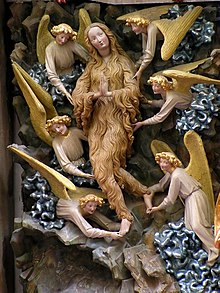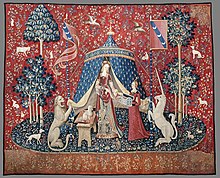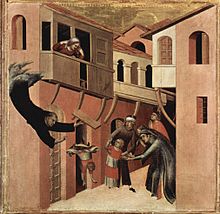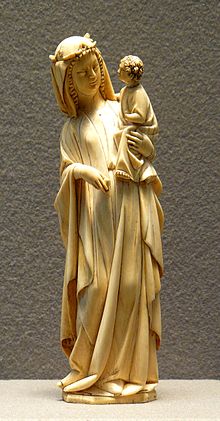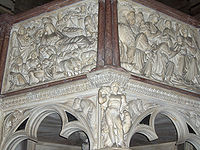
Romanesque architecture is an architectural style of medieval Europe that was predominant in the 11th and 12th centuries. The style eventually developed into the Gothic style with the shape of the arches providing a simple distinction: the Romanesque is characterized by semicircular arches, while the Gothic is marked by the pointed arches. The Romanesque emerged nearly simultaneously in multiple countries ; its examples can be found across the continent, making it the first pan-European architectural style since Imperial Roman architecture. Similarly to Gothic, the name of the style was transferred onto the contemporary Romanesque art.

Gothic architecture is an architectural style that was prevalent in Europe from the late 12th to the 16th century, during the High and Late Middle Ages, surviving into the 17th and 18th centuries in some areas. It evolved from Romanesque architecture and was succeeded by Renaissance architecture. It originated in the Île-de-France and Picardy regions of northern France. The style at the time was sometimes known as opus Francigenum ; the term Gothic was first applied contemptuously during the later Renaissance, by those ambitious to revive the architecture of classical antiquity.

An altarpiece is an work of art in painting, sculpture or relief representing a religious subject made for placing at the back of or behind the altar of a Christian church. Though most commonly used for a single work of art such as a painting or sculpture, or a set of them, the word can also be used of the whole ensemble behind an altar, otherwise known as a reredos, including what is often an elaborate frame for the central image or images. Altarpieces were one of the most important products of Christian art especially from the late Middle Ages to the era of Baroque painting.

International Gothic is a period of Gothic art which began in Burgundy, France, and northern Italy in the late 14th and early 15th century. It then spread very widely across Western Europe, hence the name for the period, which was introduced by the French art historian Louis Courajod at the end of the 19th century.

The art of Europe, also known as Western art, encompasses the history of visual art in Europe. European prehistoric art started as mobile Upper Paleolithic rock and cave painting and petroglyph art and was characteristic of the period between the Paleolithic and the Iron Age. Written histories of European art often begin with the Aegean civilizations, dating from the 3rd millennium BC. However a consistent pattern of artistic development within Europe becomes clear only with Ancient Greek art, which was adopted and transformed by Rome and carried; with the Roman Empire, across much of Europe, North Africa and Western Asia.

The medieval art of the Western world covers a vast scope of time and place, with over 1000 years of art in Europe, and at certain periods in Western Asia and Northern Africa. It includes major art movements and periods, national and regional art, genres, revivals, the artists' crafts, and the artists themselves.
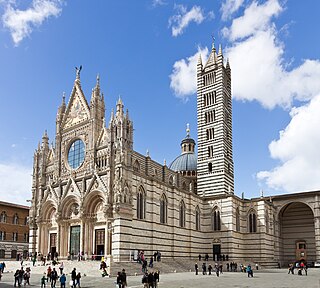
Siena Cathedral is a medieval church in Siena, Italy, dedicated from its earliest days as a Roman Catholic Marian church, and now dedicated to the Assumption of Mary.

French art consists of the visual and plastic arts originating from the geographical area of France. Modern France was the main centre for the European art of the Upper Paleolithic, then left many megalithic monuments, and in the Iron Age many of the most impressive finds of early Celtic art. The Gallo-Roman period left a distinctive provincial style of sculpture, and the region around the modern Franco-German border led the empire in the mass production of finely decorated Ancient Roman pottery, which was exported to Italy and elsewhere on a large scale. With Merovingian art the story of French styles as a distinct and influential element in the wider development of the art of Christian Europe begins.

Romanesque art is the art of Europe from approximately 1000 AD to the rise of the Gothic style in the 12th century, or later depending on region. The preceding period is known as the Pre-Romanesque period. The term was invented by 19th-century art historians, especially for Romanesque architecture, which retained many basic features of Roman architectural style – most notably round-headed arches, but also barrel vaults, apses, and acanthus-leaf decoration – but had also developed many very different characteristics. In Southern France, Spain, and Italy there was an architectural continuity with the Late Antique, but the Romanesque style was the first style to spread across the whole of Catholic Europe, from Sicily to Scandinavia. Romanesque art was also greatly influenced by Byzantine art, especially in painting, and by the anti-classical energy of the decoration of the Insular art of the British Isles. From these elements was forged a highly innovative and coherent style.

The term Poor Man's Bible has come into use in modern times to describe works of art within churches and cathedrals which either individually or collectively have been created to illustrate the teachings of the Bible for a largely illiterate population. These artworks may take the form of carvings, paintings, mosaics or stained-glass windows. In some churches a single artwork, such as a stained-glass window, has the role of Poor Man's Bible, while in others, the entire church is decorated with a complex biblical narrative that unites in a single scheme.

Cahors Cathedral is a Roman Catholic church located in the town of Cahors, Occitanie, France. A national monument, it is an example of the transition between the late Romanesque and Gothic architectural traditions.

Prato Cathedral, or Cathedral of Saint Stephen, is a Roman Catholic cathedral in Prato, Tuscany, Central Italy, from 1954 the seat of the Bishop of Prato, having been previously, from 1653, a cathedral in the Diocese of Pistoia and Prato. It is dedicated to Saint Stephen, the first Christian martyr.

Italian Renaissance painting is the painting of the period beginning in the late 13th century and flourishing from the early 15th to late 16th centuries, occurring in the Italian Peninsula, which was at that time divided into many political states, some independent but others controlled by external powers. The painters of Renaissance Italy, although often attached to particular courts and with loyalties to particular towns, nonetheless wandered the length and breadth of Italy, often occupying a diplomatic status and disseminating artistic and philosophical ideas.
Croatian art describes the visual arts in Croatia, and art by Croatian artists from prehistoric times to the present. In Early Middle Ages, Croatia was an important centre for art and architecture in south eastern Europe. There were many Croatian artists during the Medieval period, and the arts flourished during the Renaissance. Later styles in Croatia included Baroque and Rococo.

The Nativity of Jesus has been a major subject of Christian art since the 4th century.
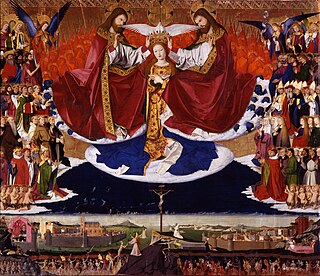
Catholic art is art produced by or for members of the Catholic Church. This includes visual art (iconography), sculpture, decorative arts, applied arts, and architecture. In a broader sense, Catholic music and other art may be included as well. Expressions of art may or may not attempt to illustrate, supplement and portray in tangible form Catholic teaching. Catholic art has played a leading role in the history and development of Western art since at least the 4th century. The principal subject matter of Catholic art has been the life and times of Jesus Christ, along with people associated with him, including his disciples, the saints, and motifs from the Catholic Bible.

The Cathedral of Santa María, known as the Old Cathedral, is one of the two cathedrals in Salamanca, Castile and León, Spain. Founded by Bishop Jerome of Périgord, its construction began in the first third of the 12th century and was finished at the end of the 14th century, in Romanesque and Gothic style. It was finished thanks to the impulse given to the works by Bishop Alfonso Barasaque. It is dedicated to Saint Mary of the See.
The architecture of Switzerland was influenced by its location astride major trade routes, along with diverse architectural traditions of the four national languages. Romans and later Italians brought their monumental and vernacular architecture north over the Alps, meeting the Germanic and German styles coming south and French influences coming east. Additionally, Swiss mercenary service brought architectural elements from other lands back to Switzerland. All the major styles including ancient Roman, Romanesque, Gothic, Renaissance, Baroque, Neoclassical, Art Nouveau, Modern architecture and Post Modern are well represented throughout the country. The founding of the Congrès International d'Architecture Moderne in La Sarraz and the work of Swiss-born modern architects such as Le Corbusier helped spread Modern architecture throughout the world.

Italo-Byzantine is a style term in art history, mostly used for medieval paintings produced in Italy under heavy influence from Byzantine art. It initially covers religious paintings copying or imitating the standard Byzantine icon types, but painted by artists without a training in Byzantine techniques. These are versions of Byzantine icons, most of the Madonna and Child, but also of other subjects; essentially they introduced the relatively small portable painting with a frame to Western Europe. Very often they are on a gold ground. It was the dominant style in Italian painting until the end of the 13th century, when Cimabue and Giotto began to take Italian, or at least Florentine, painting into new territory. But the style continued until the 15th century and beyond in some areas and contexts.

